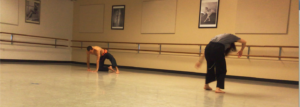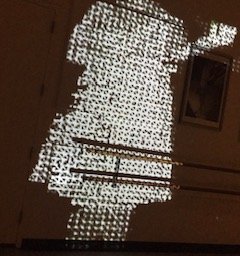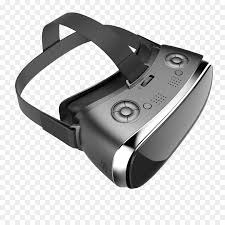What is the Sound of a Muscle Flexing?
Who are we if we can “hear” electrical currents that move through the muscles? What is the sound of muscle’s flexing? Does it make a waterfall of the body?

Last week Wei brought in sensors that pick up data about electrical currents that run through the muscles, allowing them to contract or relax. The sensors were originally developed for medical purposes, allowing us to talk about things like heart-arhythmias and murmurs as well as nutritional imbalances. In an artistic space there is a chance to engage with our emotions about being able to track such things through electrochemical flows and also a chance to think about our relationship with our muscles, and their tension-release-based balancing motions.
There are, of course, an infinite number of ways to mapping the data collected by the sensors onto things that provide that data with meaning. Charts and numbers are the maps preferred by medicine, but in mapping the sensed data onto sounds, Wei offers the opportunity for us to develop a feel for our muscles and the processes within the body that make the muscles move.
What kind of sound should be used to map the data is an important question? I’ve seen Wei try everything from a thumping sound, recognizable as the heart in our old stethoscope-based models, to a more dispersed oceanic sound more akin to the sound of ripping, or a slow eruption. These sounds are triggered by a bunching and relaxing of the muscles.
Watching various dancers test the device, I’ve noticed how difficult it is to distinguish muscle movement from motion. Our 20th, century conceptions of how bodies move, however, is based o a physics of friction and mass, where for example, an arm might pushing aside molecules, whooshing as it whips through the air; when the foot stomps it’s the impact of one mass hitting another that makes the thump.
Tracking electrical impulses is somehow different, more akin to water and flows, as well as stimuli and responses. In the Kinetech Labs we’ve asked what sort of movements are needed in order to draw our attention to the activity specific to muscles? What dance can help us hear and see what is specific to the new things we are now able to sense.
I’ve seen performances reminiscent of Frankenstein, and have been reminded of Stravinsky’s Petrushka, but thus far it’s in the short jerky movements of laughter that I have felt the muscles most. Yes, these jerky movements are associated with motion, but there is something about the way that the diaphragm bunches and releases that most seems to draw attention to the muscles doing their thing. Laughter, and of course, the heart whose squeezing and releasing we know so well. How to make a dance of these elements is the question. Tension, relaxation, tension, relaxation and varying pulses of these things.
I think these rhythms are what make me think of a landscape with many waterfalls, those speedy sections of high intensities and the pool they fall into, for a muscle is no good unless it pulls up on another thing, and it cannot pull unless it also has a moment to release.
Considering the problem of electricity within the body, I think, also of electrolytes that set up the electrical differentials that allow currents to flow through the body. Electrical charges floating through us, in an a nutrition-based milieu, where a cup of Kava tea, and slow all of the movements of a landscape, loosening the flow of currents and allowing the muscles, briefly to to relax. What soundtrack is needed to see this soup?



